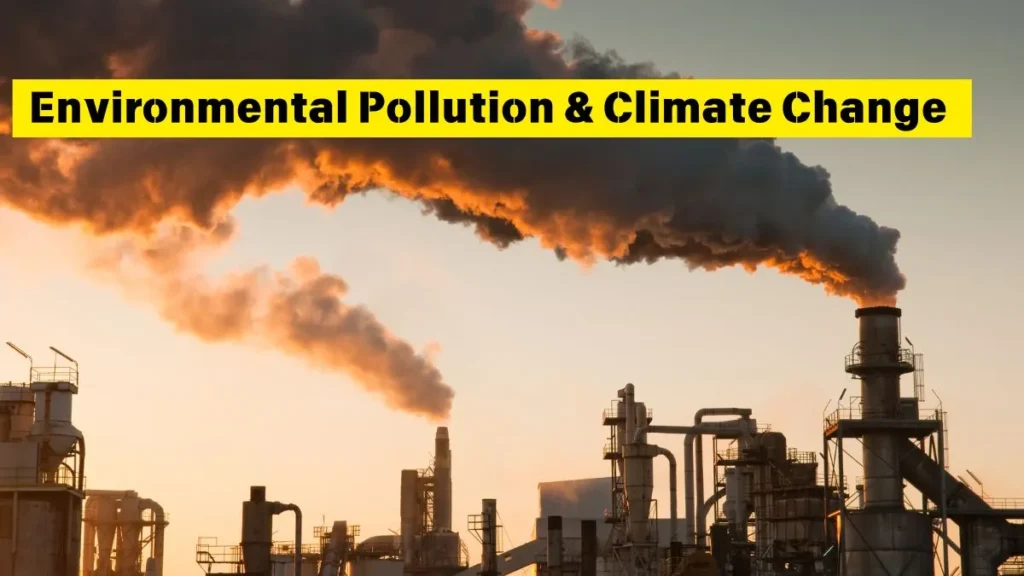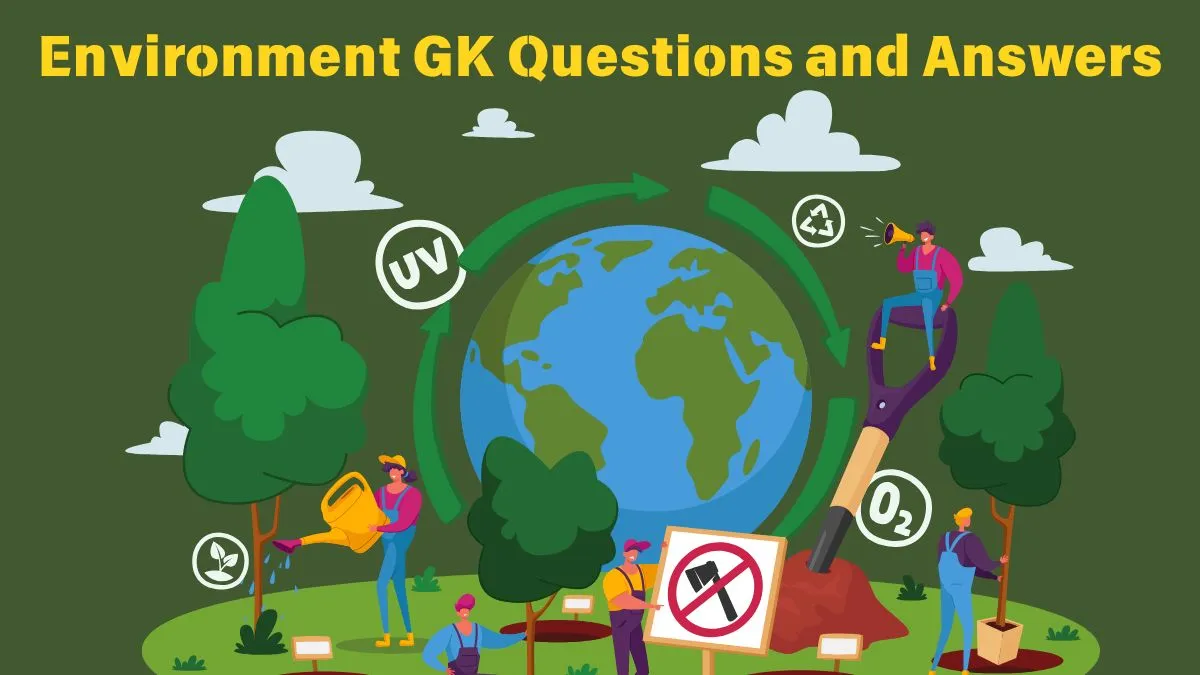Table of Contents
Are You Preparing for Competitive Exams?
If you answer yes, you must be aware that environment-related questions frequently appear in exams like SSC, UPSC, Railways, Banking, and other competitive tests.
Welcome to your ultimate guide on Environment GK Questions and Answers.
In this article, we bring you the 50 Most Important Environment General Knowledge Questions with Answers that are frequently asked in every competitive exam. Whether you know the sky blushes red at sunset? What keeps clouds floating like cotton candy in the sky? Don’t know, Stick with us, and by the end, you’ll not only have the answers but also the confidence to tackle any environmental trivia challenge.
Environment GK Questions and Answers on General Science

Q. What is the percentage of carbon dioxide in the air?
Answer: 0.042%
Explanation: The concentration of carbon dioxide (CO₂) in the atmosphere is 0.042%. It plays a crucial role in photosynthesis and the greenhouse effect.
Q. Which atmospheric layer is closest to the Earth?
Answer: Troposphere (also called “Chhobh Mandal”).
Explanation: The Troposphere is the lowest atmospheric layer where weather changes occur. It extends up to 8-15 km from the Earth’s surface.
Q. In which season does the thickness of the atmosphere increase?
Answer: Summer.
Explanation: The atmosphere expands in summer due to higher temperatures, causing gases to spread out and slightly increase the height of layers like the troposphere, though air density decreases.
Q. What instrument is used to measure humidity in the air?
Answer: Hygrometer.
Explanation: A Hygrometer is an instrument used to measure air moisture levels, which helps in weather forecasting and climate studies.
Q. What is the presence of water vapour in the air called?
Answer: Humidity
Explanation: The presence of water vapour in the air is known as humidity, which influences weather conditions like rainfall and fog.
Q. What percentage of Earth’s water is freshwater?
Answer: 2.5%.
Explanation: Only 2.5% of Earth’s water is freshwater, with most of it stored in glaciers, ice caps, and underground reservoirs.
Q. What percentage of the Earth’s surface is covered by water?
Answer: 71%.
Explanation: About 71% of Earth’s surface is covered by water, including oceans, seas, rivers, and lakes.
Q. What is the primary source of energy on Earth?
Answer: The Sun (Solar Energy).
Explanation: The Sun is the main energy source, providing heat and light essential for life, weather, and climate.
Q. Where are Rhizobium bacteria found?
Answer: Near the roots of plants.
Explanation: Rhizobium bacteria are found in the root nodules of leguminous plants and help in nitrogen fixation, enriching soil fertility.
Q. Which gases help in maintaining Earth’s temperature?
Answer: Carbon dioxide (CO₂) and water vapor, CH4 and N2O
Explanation: Carbon dioxide (CO₂), water vapour, methane (CH₄), and nitrous oxide (N₂O) trap heat in the atmosphere, helping maintain Earth’s temperature and prevent extreme fluctuations.
GK Questions on Environmental Pollution & Climate Change

Q. What is the ozone layer, and why is it important?
Answer: The ozone layer in the stratosphere protects Earth from harmful UV rays.
Explanation: The ozone layer in the stratosphere absorbs harmful ultraviolet (UV) rays, protecting life on Earth from radiation. The ozone layer in the stratosphere, absorbs harmful ultraviolet (UV) radiation, preventing skin cancer and DNA damage in living organisms. Prolonged exposure to UV rays can also harm the in various ways. Test your knowledge with GK Questions on Human Body.
Q. Which gases are responsible for global warming?
Answer: Carbon dioxide (CO₂), methane (CH₄), and water vapour.
Explanation: CO₂, methane (CH₄), and nitrous oxide (N₂O) trap heat, increasing global temperatures and leading to climate change.
Q. What are the main causes of air pollution?
Answer: Vehicle emissions, industrial waste, and burning fossil fuels.
Explanation: Vehicle emissions, industrial waste, and burning of fuels release harmful pollutants, hence decreasing the quality of air.
Q. What causes acid rain?
Answer: Sulfur dioxide (SO₂) and nitrogen oxides (NOx) mix with atmospheric water.
Explanation: Acid rain occurs when sulfur dioxide (SO₂) and nitrogen oxides (NOx) mix with atmospheric moisture, forming acidic precipitation.
Q. What is the Greenhouse Effect?
Answer: The trapping of heat by greenhouse gases, leads to global warming.
Explanation: The greenhouse effect traps heat in Earth’s atmosphere, keeping the planet warm but also contributing to global warming.
Q. What are the major effects of global warming?
Answer: Melting glaciers, rising sea levels, and extreme weather conditions.
Explanation: It causes rising sea levels, extreme weather, and biodiversity loss and thus, impacting ecosystems worldwide.
Q. How does deforestation impact the environment?
Answer: Increases CO₂ levels, leads to climate change, and causes loss of biodiversity.
Explanation: Deforestation leads to climate change, loss of biodiversity, and increased carbon dioxide levels in the atmosphere.
Q. What is the ecological footprint?
Answer: The measure of human impact on nature in terms of resource use.
Explanation: It measures the impact of human activities on nature by calculating resource consumption and waste production.
Q. What are the major contributors to plastic pollution?
Answer: Non-biodegradable plastics harm marine life and ecosystems.
Explanation: Single-use plastics, improper waste disposal, and ocean dumping lead to severe environmental hazards.
Q. How does noise pollution affect human health?
Answer: It can cause hearing loss, stress, and sleep disturbances.
GK Questions on Ecosystem & Biodiversity

Q. What is biodiversity, and why is it important?
Answer: Biodiversity refers to the variety of life on Earth, ensuring ecosystem balance.
Q. What is the nitrogen cycle, and who maintains it?
Answer: The nitrogen cycle is maintained by microorganisms that help in nitrogen fixation.
Explanation: The nitrogen cycle is maintained by microorganisms that convert nitrogen into usable forms for plants and animals.
Q. What is an ecosystem?
Answer: A system where living organisms interact with their physical environment.
Explanation: An ecosystem is a community of living organisms interacting with their environment, forming a balanced system.
Q. How do human activities impact ecosystems?
Answer: Deforestation, pollution, and climate change disrupt natural balance.
Q. What are the five layers of the atmosphere?
Answer: Troposphere, Stratosphere, Mesosphere, Thermosphere, and Exosphere.
Q. Which atmospheric layer has a stable temperature?
Answer: Stratosphere (also known as the “Samtaap Mandal”).
Q. Why is afforestation important?
Answer: It helps combat deforestation, improves air quality, and supports wildlife.
Q. How can we reduce deforestation?
Answer: Planting trees, sustainable farming, and reducing paper use.
Q. Which soil is best for cotton cultivation?
Answer: Black soil.
Explanation: Black soil retains moisture and nutrients, making it ideal for growing cotton.
Q. How can soil erosion be prevented?
Answer: Afforestation, terracing, and using crop rotation.
GK Questions on Energy Conservation & Sustainable Development

Q. What are renewable energy sources?
Answer: Solar, wind, hydro, and geothermal energy.
Explanation: Solar, wind, hydro, and geothermal energy are sustainable sources that reduce environmental harm and can be reused.
Q. What is the main advantage of using renewable energy?
Answer: It reduces pollution and dependence on fossil fuels.
Q. What are fossil fuels?
Answer: Coal, oil, and natural gas
Explanation: Coal, oil, and natural gas are fossil fuels, formed from decomposed plants and animals over millions of years.
Q. Why should we reduce fossil fuel consumption?
Answer: To lower air pollution and reduce greenhouse gases.
Q. What is the Air Quality Index (AQI)?
Answer: A measure of pollution levels in the air.
Explanation: AQI measures air pollution levels, indicating whether the air is safe to breathe.
Q. How does climate change affect agriculture?
Answer: It alters rainfall patterns and reduces crop yields.
Explanation: It leads to unpredictable rainfall, droughts, and crop failures, affecting food production.
Q. How can individuals reduce their carbon footprint?
Answer: By using public transport, planting trees, and switching to green energy.
Explanation: By implementing this method an individual can reduce carbon emissions.
Q. What is the importance of waste management?
Answer: It prevents pollution and conserves resources.
Explanation: Proper waste management reduces pollution, conserves resources, and promotes sustainability.
Q. What are biodegradable and non-biodegradable wastes?
Answer: Biodegradable wastes decompose naturally, while non-biodegradable ones do not.
GK Questions on Water Conservation & Climate Adaptation

Q. What is the water cycle?
Answer: The process of evaporation, condensation, precipitation, and collection.
Q. What is water scarcity, and how can it be managed?
Answer: Water scarcity occurs due to overuse and can be managed through conservation.
Q. What is rainwater harvesting?
Answer: Collecting and storing rainwater for future use.
Q. How can industries reduce pollution?
Answer: By using eco-friendly technology and proper waste disposal methods.
Q. What role do wetlands play in the environment?
Answer: They act as natural water filters and support biodiversity.
Q. Why is conserving wildlife important?
Answer: It maintains ecological balance and protects endangered species.
Q. What are the effects of urbanization on the environment?
Answer: Increased pollution, deforestation, and resource depletion.
Q. How does afforestation help in reducing global warming?
Answer: Trees absorb CO₂ and release oxygen, balancing greenhouse gases.
Q. What are some daily habits that can help protect the environment?
Answer: By reducing waste, using less plastic, conserving energy, and planting trees.
Conclusion
“In this article, we have looked at 50 Important Environment GK Questions and Answers, which are essential for any upcoming competitive exams. The questions included in this article will help you strengthen your environmental general knowledge and boost your confidence for exams like SSC, UPSC, Banking, and Railways.
By regularly practising these questions, you can improve your knowledge about climate change, pollution, and biodiversity. If you found these questions useful, share them with your friends.”

Kusum Rao
(Content Writer)
With extensive experience as a content writer specializing in General Knowledge Questions at ALLGKQUESTIONS.IN, my role involves researching and crafting accurate and engaging GK questions to help students prepare for Central and State-Level Competitive Government Exams. My primary goal is to provide aspirants with accurate and insightful content, ensuring they are well-prepared and confident for their examinations.

